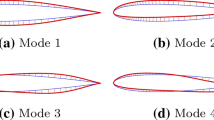Abstract
Multidisciplinary optimization (MDO) is a growing field in engineering, with various applications in aerospace, aeronautics, car industry, etc. However, the presence of multiple disciplines leads to specific issues, which prevent MDO to be fully integrated in industrial design methodology. In practice, the key issues in MDO lie in the management of the interconnections between disciplines, along with the high number of simulations required to find a feasible multidisciplinary (optimal) solution. Therefore, in this paper, a novel approach is proposed, combining proper orthogonal decomposition to decrease the amount of data exchanged between disciplines, with surrogate models based on moving least squares to reduce disciplines. This method is applied to an original 2D wing demonstrator involving two disciplines (fluid and structure). The numerical results obtained for an optimization task show its benefits in diminishing both the interfaces between disciplines and the overall computational time.
Similar content being viewed by others
References
Agte JS (2005) A tool for application of bi-level integrated system synthesis (BLISS) to multidisciplinary design optimization problems. Institute of Aeroelasticity, German Aerospace Center, Bunsenstraße 10, 37073 Göttingen
Alexandrov NM, Lewis RM (1999) Comparative properties of collaborative optimization and other approaches to MDO. Proceedings of the first ASMO UK/ISSMO conference on engineering design optimization, 8–9 July
Anderson JD (1995) Computation fluid dynamics—the basics with applications. McGraw-Hill, New York, USA, pp 547
Berkooz G, Holmes P, Lumley JL (1993) The proper orthogonal decomposition in the analysis of turbulent flows. Annu Rev Fluid Mech 25:539–575
Braun RD, Kroo IM (1997) Development and application of the collaborative optimization architecture in a multidisciplinary design environment. Multidisciplinary design optimization state of the art, SIAM Series, proceedings in applied mathematics 80:98–116
Breitkopf P, Rassineux A, Villon P (2002) An introduction to moving least squares meshfree methods. Revue européenne des éléments finis 11/7–8:825–867
Brown NF, Olds JR (2005) Evaluation of multidisciplinary optimization (MDO) techniques applied to a reusable launch vehicle. AIAA Paper 2005–707
Cramer EJ, Denis JE, Frank PD, Lewis RM, Shubin GR (1994) Problem formulation for multidisciplinary optimization. SIAM J Optim 4:754–776
Davidson L (1997) An introduction to turbulence models. Report 97/2, Dept. of Thermo and Fluid Dynamics, Chalmers University, Göteborg, Sweden
Giassi A, Bennis F, Maisonneuve JJ (2004) Multidisciplinary design optimisation and robust design approaches applied to concurrent design. Struct Multidisc Optim 28:356–371
Giunta AA, Watson LT, Koehler J (1998) A comparison of approximation modeling techniques: polynomial versus interpolating models, 7th AIAA/USAF/NASA/ISSMO symposium on multidisciplinary analysis & optimization, Sept 2–4. St. Louis, MI, USA, AIAA Paper 1998–4758
Hulme KF, Bloebaum CL (1999) A comparison of formal and heuristic strategies for iterative convergence of a coupled multidisciplinary analysis. 3rd world congress on structural and multidisciplinary optimization, Buffalo, New York, 17–21 May
Jones DR (2001) A taxonomy of global optimization methods based on response surfaces. J Glob Optim 21:345–383
Kodiyalam S, Sobieszczanski-Sobieski J (1999) Bi-level integrated system synthesis with response surfaces. 40th AIAA/ASME/ASCE/AHS/ASC structures, structural dynamics and materials conference, April 12–15, St. Louis, MI, USA. AIAA Paper 1999–1306-wip
Lefrançois E (2005) http://www.utc.fr/~mecagora/
LeGresley PA, Alonso JJ (2004) Improving the performance of design decomposition methods with POD. 10th AIAA/ISSMO multidisciplinary analysis and optimization conference, Aug 30–Sept 1, Albany, NY, USA. AIAA Paper 2004–4465
LeGresley P A (2005) Application of proper orthogonal decomposition (POD) to design decomposition methods. PhD thesis, Department of Aeronautics and Astronautics, Stanford University, USA
Masmoudi M, Parte Y (2006) Disciplinary interaction variable elimination (DIVE) approach for multi-disciplinary optimization. ECCOMAS CFD-2006, In: Wesseling P, Oñate E, Périaux J (eds) Egmond aan Zee, The Netherlands, 5–8 September
Naceur H (1998) Contribution à loptimisation de forme de structures minces en présence de non linéarités géométriques et matérielles. PhD thesis, Département de Génie des Systèmes Mécaniques, Université de Technologie de Compiègne, France
Nayroles B, Touzot G, Villon P (1992) Generalizing the finite element method: diffuse approximation and diffuse elements. Comput Mech 10:307–318
Newman A (1996) Model reduction via the Karhunen–Loève expansion. Part I: An exposition. Technical Report TR96–32, Inst. Systems Research, April 1996
Padula SL, Korte JJ, Dunn HJ, Salas AO (1999) Multidisciplinary optimization branch experience using iSIGHT software. NASA Technical Report TM-1999-209714
Pierret S, Filomeno Coelho R, Kato H (2007) Multi-disciplinary and multiple operating points shape optimization of three-dimensional compressor blades. Struct Multidisc Optim 33–1:61–70
Simo JC, Vu-Quoc L (1986) A three-dimensional finite-strain rod model. Part II: computational aspects. Comput Methods Appl Mech Eng 58–1:79–116
Simpson TW, Korte JJ, Mauery TM, Mistree F (1998) Comparison of response surface and kriging models for multidisciplinary design optimization. 7th AIAA/USAF/NASA/ISSMO Symposium on Multidisciplinary Analysis & Optimization, St. Louis, MI, USA. AIAA Paper 1998–4755, 2–4 September
Sobieszczanski-Sobieski J, Agte J, Sandusky R (1998) Bi-level integrated system synthesis (BLISS). Langley Research Center, Hampton, Virginia, NASA Technical Report TM-1998-208715
Sobieszczanski-Sobieski J (1988) Optimization by decomposition: a step from hierarchic to non-hierarchic systems. NASA Technical Report CP-3031
Tedford N, Martins J (2006) On the common structure of MDO problems: a comparison of architectures. 11th AIAA/ISSMO multidisciplinary analysis and optimization conference. Portsmouth, Virginia, USA, 6–8 September
Vinoski S (1997) CORBA: integrating diverse applications within distributed heterogeneous environments. IEEE Communications Magazine, IEEE Computer Society, Washington DC, USA, 14–2
Wright S, Nocedal J (1999) Numerical optimization. Springer series in operation research. Springer-Verlag, New York pp 634
Zadeh PM, Toropov VV, Wood AS (2005) Use of moving least squares method in collaborative optimization. 6th world congress on structural and multidisciplinary optimization. Rio de Janeiro, Brazil May 30–June 3
Author information
Authors and Affiliations
Corresponding author
Rights and permissions
About this article
Cite this article
Filomeno Coelho, R., Breitkopf, P. & Knopf-Lenoir, C. Model reduction for multidisciplinary optimization - application to a 2D wing. Struct Multidisc Optim 37, 29–48 (2008). https://doi.org/10.1007/s00158-007-0212-5
Received:
Accepted:
Published:
Issue Date:
DOI: https://doi.org/10.1007/s00158-007-0212-5




